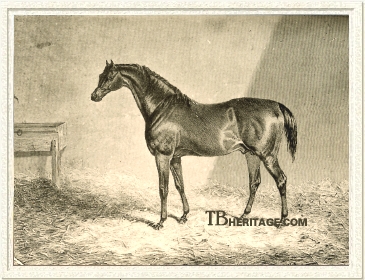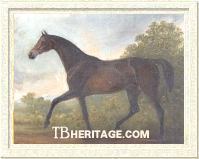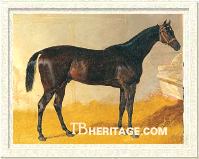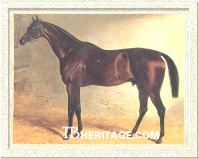|
|
Liverpool

|
|
 |
|
|
Liverpool was a game, solid north country stayer that got one classic winner and a superior handicap horse, LANERCOST, that continued this branch of the Tramp sire line for a few generations. He is seen in today's pedigrees through his daughters, and the daughters of his sons and grandsons.
Bred at the Bishop Burton stud of Richard Watt in Yorkshire, Liverpool's dam, a mare by Whisker, also bred by Watt, was out of the great broodmare, Mandane, and was a half-sister to Oaks winner Manuella, to St. Leger winner Altisidora, to the great Lottery, and to the good stayer and stallion Brutandorf. Unlike several of her half-sisters, Liverpool's dam, who was sold after dropping Liverpool, bred seven live foals before her death in 1836, and was a modest producer. Other than Liverpool, her first foal, born in 1828, her best was Waresti (1832, by Sultan), a winner of Goodwood's Molecomb Stakes and a sweepstakes at Newmarket Craven, that was sold to the Dutch government in 1837.
Liverpool was closely-related to Lottery, Altisidora, and Manuella through the sire line, as well: Lottery was by Liverpool's sire, Tramp, and the two fillies were by Tramp's sire, Dick Andrews. Tramp was an excellent four-miler, winner of several gold cups and of the Doncaster Cup (then four miles), carrying 140 pounds. He stood at Bishop Burton at the outset of his stud career, but at the time Liverpool's dam was bred he had been sold to Frederick Lumley and was standing at Tickhill Castle Farm. In addition to Lottery and Liverpool, he got five classic winners and was dam's sire of Glencoe, who was so important as a broodmare sire in the U.S.
Liverpool was, said The Druid, "remarkably clean-hocked," but he had small feet for his size, and this may have had some impact on what was a fairly light race career. He had, said The Druid, "forelegs [that] were rather too light to please the Cumberland farmers, and added to this he was a trifle ragged in his hips, and thick in his jowl."
Liverpool on the Turf
Liverpool's only race as a juvenile was a sweep for two-year-olds at Doncaster, in which he ran fourth in a field of fourteen, beaten by the filly Circassian, Colwock and Bras-de-Fer. At the end of the season he was sold to W. "Crutch" Robinson, a very successful and notorious "magnate of the Ring," who lived in Cheshire and put Liverpool in training with the Scotts in Yorkshire. William "Bill" Scott had the ride on Liverpool throughout his three-year-old season. Robinson was described by a contemporary: "...a more domineering, uncouth being than this sporting cripple, could not be encountered even in a county rather famed for such characters; and to see an old man disabled from the use of his limbs, and blanched by time, shouting out his odds, and dealing in the lowest bitter sarcasm and racing slang, either mounted on a four-legged brute, as rough as himself, or leaning on his trusty crutch, in the midst of the crushing thong, was an irreverent and revolting sight, even in the motley scene wherein he figured." Despite this harsh assessment, Robinson was considered one of the more honest bookies, and had been a favorite of the Earl of Derby fifteen years previous. Moreover, he was intimately involved in the racing scene, and knew every character, from nobbler to honourable, that frequented the turf during the wild and largely unregulated years of British racing.
Liverpool won his first race of his three-year-old season, a Produce Stakes Handicap for three-year-olds over two miles at York, a "terribly" punishing race run in 3:39, in which he ran neck-and-neck -- "one of the longest and severest struggles ever witnessed" -- with Creole (a full brother to Mulatto, by Catton) on the stretch, catching him in the last several strides and winning by a short head. The other three horses in the race were distanced after a mile. He then went to Doncaster to run in the St. Leger Stakes with a twenty-four horse field; he was not favored in the betting, and while near the front of the field at the Red House, he gave way soon after, and ended up finishing seventh, with Chorister the winner, and The Saddler second.
A few days later Liverpool met Chorister in the Gascoigne Stakes -- despite the requirement that Chorister, as St. Leger winner, being required to give 4 pounds to the rest of the field, only Liverpool, of all the other entries, showed up at the starting post, and a battle of strategy and tactics, much more obvious in those days, ensued between the two veteran jockeys, Scott, and Chorister's rider, old John Day. Scott deliberately walked Liverpool the first half-mile of the course, with Chorister walking next to him, and then both picked up a canter "scarcely above the speed of a common hack, as far as the Red House," after which they set off "at rattling speed," but neither could shake the other and it was judged a dead-heat. In the run-off, Scott sent Liverpool to the front immediately at a strong run, with Chorister left slightly behind; they ran "a splitting race home, Liverpool winning by nearly a length, and proving himself to be one of the gamest horses that ever ran." This was the end of the season for Liverpool. Robinson sold him to William Henry Vane, 1st Duke of Cleveland, who owned Chorister, for £7,000.
The next season, 1832, Liverpool won the Port Stakes at Newmarket Craven, beating a good field of five that included Vestris, that had won four big races the previous year, and Riddlesworth, that had won the Two Thousand Guineas and other good races in 1831. At Liverpool July, carrying 8 st-4 lbs, he failed to place in the Liverpool Cup, giving weight to the rest of the field, won by Consul (7 st - 9 lbs), a winner of various distance cups and royal plates, in a field that included other good ones such as Lady Elizabeth, St. Leger winner Birmingham, Colwick, and Physician. At Knutsford he won a plate worth 150 sovereigns, beating two horses, and at Doncaster he took a walk-over for the Doncaster Four Year Old Stakes, but did not place in the run for the Doncaster Cup, won by Galopade, with Colwick second and Birmingham third. He was second to Physician in the Northallerton Gold Cup, beating three others.
In 1833 he came out at York Spring to win the Gold Cup, beating four other horses. At Preston he was second to Consul in the Gold Cup, but took the Stanley Stakes, beating four others, including Birmingham. It was his last race.
Liverpool in the Stud
Liverpool was sold by Vane to John Ramshay for 750 guineas -- ten percent of what the duke had paid for him at the end of 1831, a not atypical transaction for Vane, who seldom made money on any turf-related purchase. Ramshay was the steward of Naworth Castle, Cumberland, for the Earl of Carlisle. Carlisle's principal home was Castle Howard near Malton, in Yorkshire, and he owned numerous collieries in Cumberland which were a prime source of his wealth. Ramshay had a small, but successful, stud of thoroughbreds and "cocktails," the latter used mostly as hunters, at Naworth Barns, at the castle, and also was a well-known breeder of prime West Highland cattle.
Liverpool stood at Naworth Barns and also served mares at Middlethorpe, Yorkshire, and stood for a season near Birmingham. He was sold for £2,000 to the French government at age sixteen, scheduled for export after the 1844 season. However, he was seriously burned in a fire that demolished most of Naworth Castle and associated outbuildings in May of 1844, and, in the confusion surrounding the fire's aftermath, was "...left to incompetent hands to physick, and his gut was so much torn by their previous back raking, that the glyster passed into his bowels, and he died in most fearful pain..." six months later.
Liverpool was a useful sire, with offspring that included good juvenile winners, a classic winner, and older sprinters and stayers that won some of the bigger handicaps. The grand stayer and weight-carrier, LANERCOST, was his best runner and also his best sire son; most of his other sons ended up serving half-bred mares, and their progeny are noted as winners of hurdle handicaps and in reminiscences of hunters in the field. It was Liverpool's daughters, and those of his sons, that ultimately proved more successful in the racing stud, producing a classic winner, and some great distance horses.
|

Lanercost
|
|
LANERCOST (1835, from Otis, by Bustard) was bred near Carlisle by John Wood and sold to Ramshay as a yearling, and raced in his colors four times. He was then sold to William Ramsay, a Scottish sportsman, for whom he ran until 1842, when he was sold to Yorkshire breeder and horse dealer Thomas Kirby, who retired him to stud at Murton, Yorkshire after two races that year. He was, by far, Liverpool's best runner and best sire son. He took twenty-two wins, four walk-overs, and nine places in forty starts, unplaced only five times, which included a dead-heat with Bee's Wing, where he did not opt for the run-off. As a stallion he got two classic winners and many lesser runners that won a lot of races. He was leading sire in England between 1848 and 1850 in the number of offspring that won, but with a few exceptions, the amounts earned were small, and he never reached higher than fourth place in leading sires based on progeny earnings. He was sold to France in 1853, and got a classic winner there.
|
LANERCOST'S wins included the Ascot Gold Cup and the first running of the Cambridgeshire Stakes handicap, and some memorable races against the great Bee's Wing. His classic-winning offspring were Van Tromp (1844, from Barbelle, by Sandbeck, also the dam of The Flying Dutchman), Catherine Hayes (1850, from Constance by Partisan), and in France, Gustave (1857, from Prix de Diane winner Bounty, by Inheritor). His other good winners in England and France included Doncaster Cup winner War Eagle; the good cup mare Haricot and the excellent stayer and weight-carrier Ellderdale, both later superior broodmares; the stayer Gouvieux, and the versatile gelding Cosmopolite, that won on the flat and over fences in England and France. His sire line continued for several generations -- to Tim Whiffler in Australia, and Lecturer in England -- but his blood is seen today only through descendants of his daughters.
LANERCOST'S full sister, OTISINA (1837), produced two good daughters, Hybla (by The Provost) and Donna (by Hetman Platoff), both of which extended the female line into the present; Hybla became the dam of Epsom Derby winner and stallion Kettledrum and of Epsom Oaks winner Mincemeat (1851, by Sweetmeat), in turn dam of One Thousand Guineas winner Tomato (1861, by King Tom). The female line extending from Otisina includes numerous classic winners in England, France, Italy, and the U.S.: Alydar's Best, Ugolino da Siena, Tom Fool, Dust Commander, Border Minstrel, Hula Dancer, and Balladier are just a few representatives of this family.
The only other thoroughbred mare Liverpool saw in his first season at stud was Rachel, by Amadis. Her 1835 foal, WEE WILLIE, won a sweepstakes at Liverpool Craven meeting and went on to Manchester to win the St. Leger Stakes, and the next day, the Broughton Stakes. At age four his wins included Manchester's Broughton Stakes a second time, and he was still winning races, albeit at the selling level, at age seven.
In 1836 the good broodmare Comedy, by Comus, dropped a brown Liverpool colt for her owner, Richard Jaques at Easby Abbey in Yorkshire. Named MALVOLIO, he was purchased by Lord Eglinton, and for him he won the Champagne Stakes at Holywell Hunt as a juvenile, and the following year took the Manchester St. Leger Stakes, the Newton St. Leger Stakes and the Caledonian St. Leger.
Two sturdy brothers out of an Emilius mare, bred and raced by Ramshay, were MOSS TROOPER and NAWORTH. The "iron-legged," gelded NAWORTH (1837) won races on the flat, including Carlisle's Corby Castle Stakes and a sweepstakes at York as a juvenile, and was second in the Liverpool Queen's Plate at age eight. MOSS TROOPER'S (1839) wins included the Doncaster Queen's Plate at age three, the two-mile Northumberland Plate for Ramshay at age four, and Queen's Plates over four miles at both Doncaster and Lincoln at age six. MOSS TROOPER later got William I'Anson's Braxey (1849, from the famous Queen Mary, and so closely related to the Lanercost filly Haricot), a long-running good distance mare whose many north country wins included the Queen's Guineas and the Caledonian Cup at the Caledonian Hunt (two and three miles respectively), that later, bred to a series of high-class stallions, established the successful Family 10 - d branch that is still active today. He also got New Brighton, and a number of other long-running, low-level distance winners.
Liverpool's daughter CALYPSO (1837, from an Orville mare) was a staying mare that took Doncaster's Park Hill Stakes at age three, and at age four the Northumberland Plate and was second in the Newcastle Gold Cup. Her female line bred on for a couple of generations.
|

A British Yeoman
|
|
A BRITISH YEOMAN (1840), bred by George Blakelock, was out of his homebred Fancy, by Osmond, who had bred a good race filly, Yarico (by Waverley) in 1834. He was, said The Druid, "the handsomest son that Liverpool ever got; and, like him, he was remarkably clean hocked." The same writer said that at stud he had little opportunity, "...otherwise there would have been few to match him, as a sire of thoroughbreds. His hunters were superb." His companion was a pony used as a teaser, Highland Laddie, that later became a noted sire of ponies and won the pony sire prize at Chester.
|
A BRITISH YEOMAN won four of his six starts as a juvenile, and placed in his other two races that season. His wins included a sweep at York Spring, beating The Bashaw; a sweep at Newcastle, beating Semiseria -- placing second to Wee Pet in a sweep and third to Winesour and Nutwith in the Tyro Stakes (3/4 mile) at that same meeting; Doncaster's Champagne Stakes, beating The Caster and three others; Doncaster's Two Year Old Stakes, beating Maria Day and eight others. At age three, he did not place in the Epsom Derby, his chance "disurbed by a most peculiar seizure...on the setting on his off arm there came a soft swelling about the size and thickness of a large dish, and a similar one above the hock on the same side." After that he ran second to Gorhambury at Newcastle in a sweep worth 70 sovereigns. He was sold to Richard M. Jaques of Easby Abbey, Yorkshire, who set a match against William le Gros to be run over two miles, each horse carrying 12 st., with 1,000 sovereigns riding on it, but A BRITISH YEOMAN was too lame to start, and the other horse took a walk-over. That was the end of his turf career.
As a stallion at Carlisle, Cumberland, standing at a fee of five guineas, A BRITISH YEOMAN got some race winners, but his primary value seems to have been as a hunter sire. He won the Royal Agricultural blood prize in 1855 as a hunter sire, and "...his stock," The Druid said, "are so much valued that his owner lately refused 500 guineas from an Irish breeder for him. The hunters by him, so far, have been of a capital stamp." Of his jumpers, the gelded Bridegroom (1852, out of Alice Maud Mary, bred by H.T. Thompson) was the best, winner in 1860 of the first running of the Grand National Hunt Steeplechase (4 miles) at Market Harborough. In 1862 he took the Liverpool Autumn Steeplechase, and placed second to The Huntsman in the Grand National Steeplechase at Aintree; his wins also included the Farndon Hill Seeplechase (3 miles, 1861), the Liverpool Hunt Club Steeplechase (4 miles, 1862 and '63, carrying 12 st. both times), and the Weatherby Steeplechase Cup. He also got the half-bred Brunette, dam of a winning steeplechaser, Moslem, and the grandam of a famous Carlisle hunter named Jester. Of A BRITISH YEOMAN'S flat-racers, most ran and won at minor venues such as Eccles and Whitehaven, but he did get Baroda (1852), winner of the Doncaster Purse, and Bourgeois (1850), winner of a number of races, including The Shorts at Chester (7 furlongs) and the Northallerton Handicap (1 mile).
THE COMMODORE (1836), also bred by Blakelock, was a full brother to A BRITISH YEOMAN. Unbeaten, his wins included Doncaster's Tyro Stakes as a juvenile and, sold to the Duke of Cleveland, York's Derby Stakes at age three.
|

Idas
|
|
IDAS (1845), out of Marpessa, by Muley, had "an extraordinary stride" and a docile temperament. His dam, Marpessa, had won Newmarket's Nursery Stakes as a juvenile and the next year took Goodwood's Racing Stakes and a match against Oaks winner Vespa at Newmarket. Retired to the Hampton Court stud, she was sold with the famous Glencoe filly, Pocahontas, at her side when the stud was dispersed in 1837, and entered the stud of John Rous, second Earl of Stradbroke, who was the brother of the more famous turfite, Captain--then Admiral--Rous. Pocahontas went on to become the most noted broodmare of the ninteenth century. IDAS, raced by Lord Stradbroke, won the Two Thousand Guineas, took a walk-over for the Newmarket Stakes, and was favored at 3:1 for the Derby, but ran unplaced. At Ascot that year, he won the St. James's Palace Stakes, and was second by a head to Jericho in the Grand Duke Michael Stakes, but he subsequently lost form. As a stallion he got some winners over hurdles.
|
Some of Liverpool's other runners included Captain O.V. Harcourt's SIR ABSTRUPUS (1840, from Marsala by Jerry), winner of a juvenile race at Stockton and Goodwood's Steward's Cup (6 furlongs) at age four. FULL SAIL (1842, out of a Rubini mare), won Epsom's Woodcote Stakes as a juvenile, later sent to Holland.
One son, also called LIVERPOOL, was sold in-utero at the auction of Sir Gilbert Heathcote's stock in February of 1843. His dam, Shirine, by Blacklock, was shipped to France where she dropped LIVERPOOL shortly thereafter. Racing for August Aumont, he won the Prix du Printemps, beating the Prix de Diane winner Dorade, at age three. At age four he was among the best of the older horses, winning the Prix du Cadran (4,000 meters), the Prix de la Ville de Paris, and the Prix des Haras. The next year, age five, he won two provincial races worth 7,000 francs.
In addition to OTISINA, Liverpool also got some good broodmare daughters, such as EXECUTRIX (1836, from Hand Maiden by Walton), the dam of the great north country staying mare Inheritress (1840, by The Saddler), winner of the Northumberland Plate, Ayr Gold Cup, numerous Queen's Plates, Liverpool cup, Cheshire Stakes, Chesterfield Handicap, Wolverhampton Gold Cup, and many other races. Through Inheritress the tail-female family was responsible for numerous classic winners in Germany and some successful stallions, including the Dark Ronald son, Herold (1917), and a branch of her family was successful in South America.
BEESWAX (1839, from an Adrossan mare) was a half-sister to Doncaster Cup winner Tomboy and to the famous racemare and broodmare Bee's Wing. She ran for her breeder, William Orde, winning a 50 at Ripon and second in a sweep for three-year-olds (over 2 miles) at age three. In the stud she was the dam of Ascot's New Stakes winner Hybla, Chesterfield Stakes winner Hydromel (1855) and Goodwood Stakes winner The Roman Candle (1854).
ESPOIR (1841, from Esperance by Lap Dog), became the dam of Oaks winner Brown Duchess (1858, by The Flying Dutchman), also winner of the Park Hill Stakes and Yorkshire Oaks; Park Hill Stakes winner Battaglia (1861, by Rataplan), and Epsom's City and Suburban handicap winner Ethelbert (1850, by Faugh-a-Ballagh). Espoir's female line continued through several daughters and included Kentucky Derby winners His Eminence (1898) and Joe Cotton (1882), the outstanding race mare La Camargo (1898), Arc de Triomphe winner and stallion Massine (1920), and other classic winners in Germany, the U.S., South Africa and New Zealand.
JAMAICA (1841, from the well-bred One Thousand Guineas winner Preserve, by Emilius) was dam of the two-mile Ascot Gold Vase winner Cariboo (1847, also second in the Goodwood Cup), of the perennial runner-up Yellow Jack (1853, second in the Epsom Derby, Goodwood Cup and other top races), and of John Davis (1861), winner of the Great Yorkshire Stakes, Great Northampton Stakes and other races.
Another good mare that saw Liverpool in 1840 was Oaks and St. Leger winner Queen of Trumps; her 1841 filly by Liverpool, PRINCESS ALICE, established a successful female line that included Irish classic winners and good stakes winners in Italy, Argentina and the U.S.
--Patricia Erigero |
|
|
|

